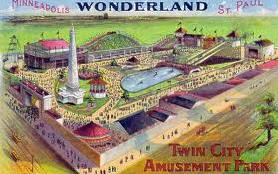Although St. Louis Park did not any amusement parks within its borders, Parkites have had access to several such parks through the years. Here are a few of them:
ANTLERS PARK
Antlers Park was a 40 acre amusement park located on Lake Marion in Lakeville, Minnesota. Colonel Marion Savage built Antlers Park to attract passengers to the Dan Patch Railroad.
Rose Anne Hanft:
In order to attract a multitude of passengers [to his Dan Patch Railroad, Marion] Savage put Antlers Park on the map [named in allusion to the former abundance of deer in this region]. It was located on the southeast shore of Prairie Lake [renamed Lake Marion in honor of Savage], and contained summer homes and facilities for picnics, boating, swimming, fishing, hunting and dancing. The excursion trains to Antlers Park were always very crowded. Those who remember riding these crowded trains remember the good times both on the ride and in the park.
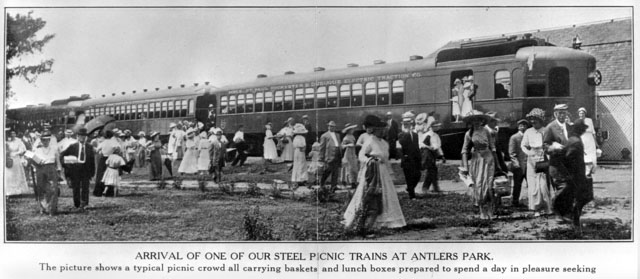
Whole families would make this trip, and, for the children, it was the big event of the summer. They would arrive at 54th and Nicollet early if they wanted a seat. At 11:00 am, a Dan Patch train pulled out of the terminal and headed south through the beautifully hilly country, past the many small stations named for the farmers whose lands the tracks cut through, past the Auto Club, the Savage farm, and finally reached Antlers Park. The people swarmed off the train and scattered to the different areas of the park. [A Minneapolis Tribune article dated April 7, 1912, reported that it took 40 minutes to get from the terminal to the park.]
The college groups usually went to the attractive pavilion. In one end of it, there was an ice cream parlor where sodas, sundaes, pop, but no liquor, were sold. The rest of the pavilion was a dance floor, tastefully decorated. Beautiful chandeliers hung from the ceiling, murals decorated the walls, and the floor was made of exceptionally find wood. The open side of the dance floor had a vine covered walk. There was always a good orchestra and dances were 10 cents for a set of three.
The people had a choice of eating a picnic lunch on the well-kept picnic grounds or in an elaborate eating place off the grounds. In the evening a band played music out on the end of the dock. The little children had fun swimming in the clear lake and riding on the merry-go-round and Ferris Wheel.
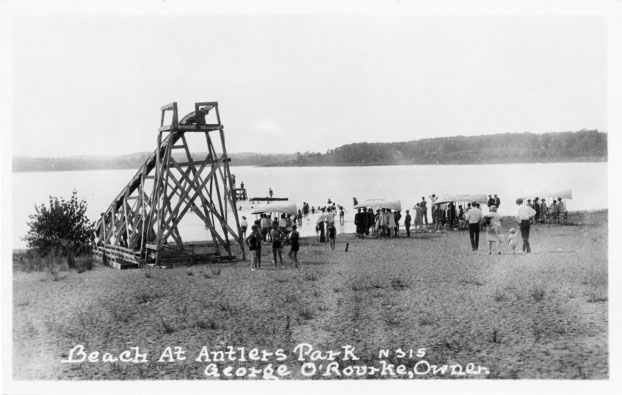
Everything in the park was up-to-date, including electricity. The means of obtaining electricity was unique. The engines of the Dan Patch provided transportation to and from the park, and the number one engine of the road, the Augerita, supplied all the electricity for Antlers Park. The Augerita ran for only one year, and because of her small passenger capacity, she was put on a siding in Antlers Park where her powerful engine generated all the electricity for the park’s facilities. [A Minneapolis Tribune article dated April 7, 1912, reported that an electric light plant was being installed at the park.]
From the Lakewood Area Historical Society:
Antlers Amusement Park became one of the most famous amusement parks in the upper Midwest. It contained a lavish dance pavilion with a gleaming oak dance floor; a large bathing beach that featured a dock, diving tower and high sliding chute; a boat dock that offered sailboats, rowboats and canoes; a children’s playground with a miniature operating train for children; tennis courts, an athletic field and baseball diamond with a grandstand for spectators; and an aerial swing. A nine-hole golf course was located nearby. The Dan Patch Railroad Line [provided transportation to the park.] Luxury excursion cars with real leather seats, stained glass upper windows and richly carved and inlaid wood brought thousands of visitors to the park each summer. On weekends in the summer of 1912, these trains reportedly made 19 scheduled runs each day.
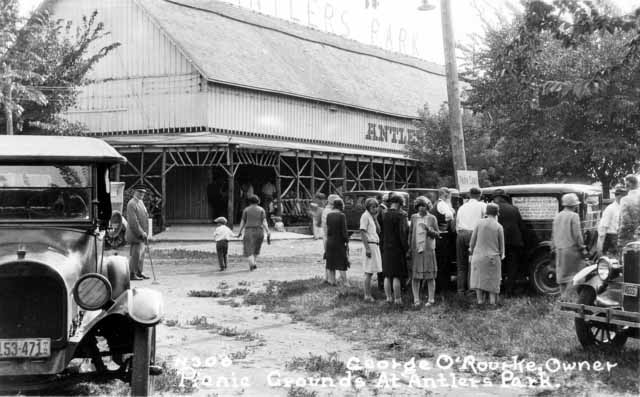
The area was already popular with wealthy families from southern states who came to escape summer heat and humidity. These families and other visitors stayed in cabins located around the lake or at Weichselbaum’s Resort, which was famous for its fried chicken, apple pie and homemade ice cream. The amusement park declined in popularity in the 1920s and 1930s due to a combination of factors – the advent of the automobile, the Great Depression and several dry years that saw Lake Marion drop to its lowest level ever.
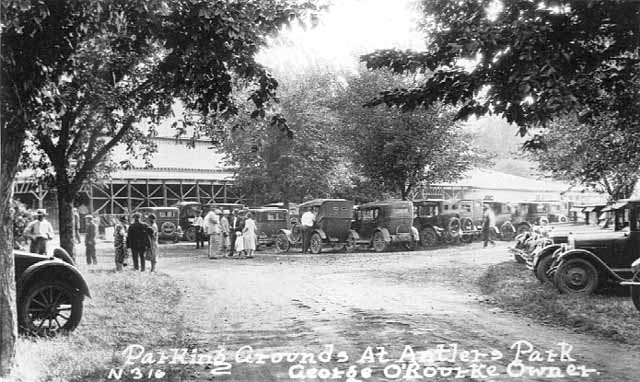
One reader tells us that
in the 1960s and early 1970s it regularly hosted picnics for many thousands of people on weekend days during the summer, typically sponsored by major corporations and unions in the Twin Cities metropolitan area, e.g., Northwest Airlines, IBEW, UAW, Honeywell, and Hitchcock Industries. When the last owners retired, they sold the park to the city of Lakeville.
BIG ISLAND PARK
Big Island Park operated from 1906 to 1911. This 65-acre park was situated on the heavily wooded Big Island on Lake Minnetonka. It was purchased in 1905 and operated by the Minneapolis and Suburban Railroad Co., a subsidiary of the Twin Cities Rapid Transit Co. (TCRT). Park-goers would take the new electric streetcar, which ran just south of St. Louis Park on 44th Street, to the Excelsior Dock, where passengers could take one of 9 streetcar boats (named Minneapolis, St. Paul, Minnetonka, Como, Minnehaha, White Bear, Hopkins, Harriet and Stillwater) to the park. The official opening was on August 5, 1906 [1907]. The boats operated until 1926.
Patrons were met with such amusements as the “Happy Hooligan Slide,” a “Figure-8 Toboggan,” and a miniature train. The park featured a large music casino, a large roller coaster, the Old Mill, the Scenic Ride to Yellowstone, and a carousel. The buildings has a Spanish mission theme. A 200 ft. tower dominated the park.
The price was only 25 cents, including the streetcar ride, and it became clear that it was not a profitable operation, especially after the TCRT also bought the Tonka Bay Hotel. Both the park and the hotel closed at the end of the 1911 season. After sitting abandoned for a few years, the park was disassembled in 1918, its iron going to scrap iron for the (WWI) war effort. Some remaining buildings, including a mess hall, became part of a Veteran’s Camp starting in the early 20’s. The streetcar boats were discontinued in July of 1926. In 1925, Excelsior Amusement Park was built at the site of the waiting station for the streetcar boats. Streetcar boats were revived in 1996.
EXCELSIOR AMUSEMENT PARK
This, the site of many a school picnic and provider of Free Rides for Good Grades, opened on May 30, 1925 with a crowd of 20,000. The property was owned by the streetcar company to create traffic for its routes, especially on weekends. The company contracted with Fred W. Pearce, Sr., of Detroit to operate the park. During his career Pearce built 26 complete amusement parks and 30 roller coasters. Pearce soon purchased the park, and hired his cousin Bill Clapp as general manager. He also hired friend Joe Colihan as superintendant.
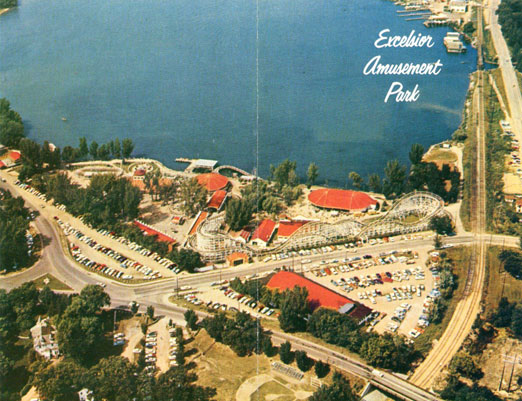
The streetcar ran from Minneapolis down 44th Street in Edina just south of St. Louis Park to the park until 1932, when it was replaced by a bus from Hopkins.
In 1933 you could see Capt. Jack Payne leap backward from a 100-foot ladder into a tank of blazing fire – THRILLING – DARING – DEATH DEFYING! You could also see Smith’s diving ponies leap from a tower 55 feet into a shallow tank of water. Other attractions were Fred Reckless on a swaying pole in 1932, and Prince Nelson, who walked the tightrope 80 feet above the ground without a net in 1931.
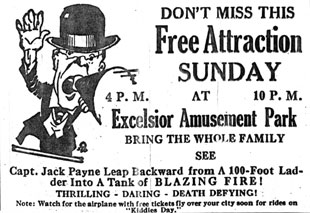
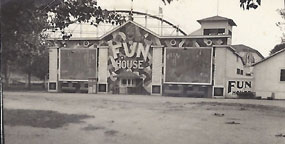
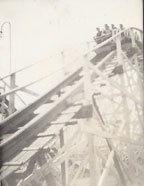
Excelsior Park Roller Coaster and Fun House, 1930s
One of the biggest attractions was the wooden rollercoaster, first called the “Mountain Ride,” then the “Cyclone.” (Folks in Excelsior just called it the Roller Coaster.) It was designed by John A. Miller and completed in April 1925. Pearce built the coaster on what had been swamp land. At a height of 65 feet it was called the highest roller coaster in the Northwest. (A higher one was built in Detroit, at 110 ft., but it was dismantled in the 1920s.) The coaster at Excelsior was 3,000 ft. long. While Pearce claimed he built the world’s first large roller coasters, he credits the invention of the device to the Russians. One memoir says that in August 1928 a real cyclone hit the park and blew the coaster apart, strewing parts onto the highway. It took ten carpenters, six laborers, and three electricians to put it back together again. When the park closed it was torn down in the winter of 1974.
The other favorite attraction was the merry-go-round, made of hand carved wood by Italian craftsmen. Fortunately, the carousel was saved and sold to Valleyfair, which opened on May 25, 1976. The horses were restored by Ray Bahmer of Hopkins during the winter of 1974-75. The building where the carousel was housed was sold to a farm near Victoria, Minnesota, where they reassembled it for a show ring for real horses.
For many years in the 1940s and ’50s the Miss Minnesota (Miss Universe) pageant was held at the park. Hopkins girl BeBe Shopp was crowned Miss Minnesota in the park in 1948, and went on to become Miss America.
Across the street from Excelsior Park was the Danceland Ballroom. It closed in 1968 and burned to the ground on July 8, 1973.
Still in the Pearce family, the park closed the weekend after Labor Day, 1973. “On July 20, 1974, an odd assortment of body parts –equipment, signs, benches and some rides — that were still salvageable were sold in an auction. The carousel went to the new amusement park, Valley Fair, near Shakopee. The merry-go-round building went to Victoria, Canada, where it served as a horse ring before burning down in 1990. The once-mighty old Cyclone was not even this lucky. It was completely dismantled and destroyed.”
There has been much written about this park, including A Picture Book of the Excelsior Amusement Park.. from Rise to Demise by the Excelsior-Lake Minnetonka Historical Society, 1991.
QUEEN ANNE KIDDIELAND
This cute little park was located at 4941 W. 78th Street, in Bloomington, south of Edina and St. Louis Park. It took up eight acres on what became a busy piece of real estate. It started out as Happy Acres Kiddie Land, and that was its name in 1950, when the Queen Anne Drive-In opened, and in 1951.
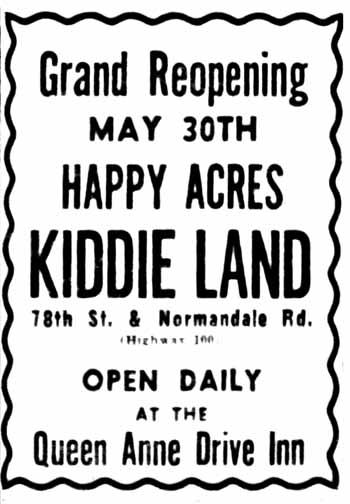
An article from a local Richfield newspaper from 1950 discusses the opening of the Queen Anne Drive-In. (Thank you for Terry Ahlstrom for the article.) It reads:
A very attractive new drive-in has been erected on 78th St., a short distance east from the Belt-Line on Normandale Rd. It is built of stone and stucco and is ultra-modern in design. It has been named the Queen Anne.
The owner and manager is Mr. T.J. Casey of 5300 W. 84th St. who named the place for his wife.
The kitchen is of stainless steel with every modern convenience that is easily kept spotlessly clean.
The Queen Anne will serve fried chicken, hamburgers, sandwiches and ice cream. It will be open from 12 noon to midnight. The opening date has been set for Friday, August 11th.
While children are enjoying rides on the miniature trains and the merry-go-round at Happy Acres the adults will enjoy a very tasty lunch at the Queen Anne. Much success to the owner in his new venture.
Here’s an article about Queen Anne Kiddieland from the Edina Historical Society’s newsletter in May 2011:
During the 1950s and ’60s, many Edina children celebrated their birthdays with a party at Queen Anne Kiddieland, a wonderland of ponies, amusement rides and the Rock Island Rocket, a miniature 1/6 scale replica of a real train.
The train was then called the Casey Jones Flyer, in honor of the popular kids’TV host Casey Jones, whose show entertained kids at lunchtime in the Twin Cities. Casey, a railroad engineer character played by actor Roger Awsumb, drove the train around the track every Sunday to the delight of his young fans.
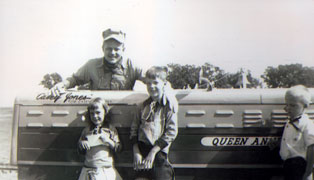
“We were packed most every Sunday,” said Boyd Thomas, who as a high school kid helped his father Frank run the pony rides at the busy amusement park, which offered party rooms and ticket specials for birthday celebrations.
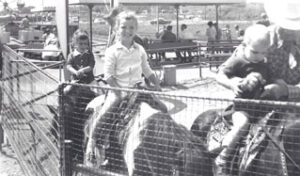
Queen Anne Kiddieland provided summer entertainment before modern amusement parks like Valleyfair opened. Kiddieland’s rides were smaller, but even teens hung out there to flirt and find dates from other towns.
Visitors recall that Queen Anne Kiddieland seemed to be in the middle of nowhere at the southeast corner of what is now the intersection of Interstates 494 and 100. But then, the land was in “the country.” In fact, the ponies came from Thomas’s 80-acre farm located a few miles away, at 78th Street and France Avenue in Bloomington, where he raised dairy cattle and hay.
By the end of the 1960s, however, the 494 strip transformed, thanks to crowds at the new Metropolitan Stadium, freeway construction and the population boom. An office tower now stands at the Queen Anne Kiddieland site, but those who want to recall their past can still ride on the Rock Island Rocket which is now housed at the Jackson Street Roundhouse in St. Paul.
The park was owned by Tom E. Casey and his wife Anne, whom he referred to as “Queen Anne.” The park was put up for sale in November 1964, but continued to function until at least 1966. The ponies were up for sale in August 1966.
After the land was sold, Casey moved the park way out to Blaine, truly the middle of nowhere at the time. The Caseys were true entrepreneurs; they built the Queen Anne Courts manufactured home community that is still in operation in Lakeville. Casey was also an avid ham radio operator, and once got in trouble with the city for erecting a radio tower at his home on Kipling Ave. Anne Casey retired to Arizona and died in 2011.
Here’s a film from 1965 for those of you on Facebook, courtesy of Jeff Kleinbaum.
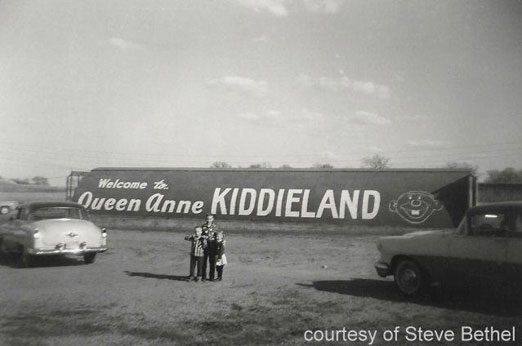
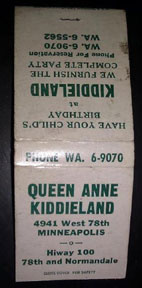
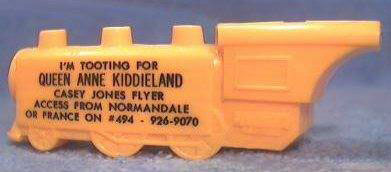
WONDERLAND PARK
Wonderland was a short-lived amusement park located on 10 acres at East Lake Street between 31st and 33rd Avenues, in today’s Longfellow neighborhood of Minneapolis. It was built by H.A. Donnelly and operated from 1905 through 1911. More than 70,000 visitors attended the park on opening day. Citizens of St. Louis Park could have reached this destination by streetcar.
Features included:
- A 120-foot-high electric tower which drew in visitors
- A roller coaster
- A miniature train,
- A floating theater
- The “House of Nonsense”
- The most popular attraction was an exhibition of premature babies in incubators, a common curiosity of the times.
For a video, click here.
The Park was demolished in April of 1911, with much of the lumber said to be used to build the houses that replaced the Park. The building that housed the incubators for premature babies is now an apartment building, according to the video.

